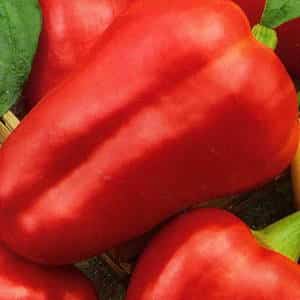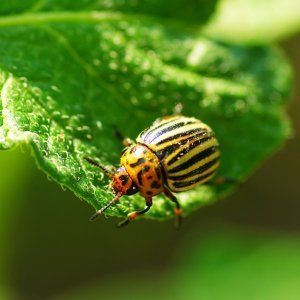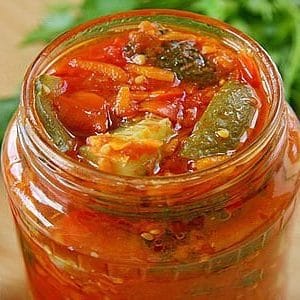Early ripening, sweet and juicy variety of pepper “Red Shovel”: review and growing instructions
The large Red Spade pepper is a favorite of gardeners across the country. The large fruits are universal in use and are suitable for preparing side dishes, salads and stuffed dishes. The flesh of the pepper is sweet and juicy, and is distinguished by a high content of vitamins A and C. Regular fertilizing and watering help to grow a rich harvest.
Let's take a closer look at what Red Shovel is and what to look for when growing it.
What type of pepper is this?
The variety is early ripening: the harvest is harvested 80 days after the appearance of the first shoots. Seedlings are prepared in early March. The variety is grown in greenhouses, greenhouses, open ground.
Peculiarities
 The bushes are low, about 70 cm in length. The leaves are medium sized, dark green.
The bushes are low, about 70 cm in length. The leaves are medium sized, dark green.
10–12 fruits ripen on one plant, so summer residents tie them to a support. The vegetable is cold-resistant, has immunity to major diseases and pests.
Fruit characteristics and yield
Cone-shaped, elongated fruits have a slightly rough surface. The weight of each varies from 120 to 160 g, in some cases reaching 200 g.
The wall thickness is 1 cm, so the crop is perfectly stored and can withstand transportation. The color is dark red, the flesh is juicy and crisp. The taste is sweet, with a pronounced aroma. Up to 7 kg of vegetables are harvested from 1 m2.
Important! Red Shovel pepper is used to prepare pickled and canned preparations for the winter: salads, snacks, lecho.The vegetable goes well with meat and fish dishes and is suitable for fresh consumption.
Preparation for cultivation
Prepare seeds for planting in advance. Select heavy and large specimens. To do this, prepare a saline solution and immerse the seeds in it for 10 minutes. After time, those seeds that sank to the bottom are selected for seedlings. The weak ones remaining on the surface are thrown away. Further preparation involves:
- Seed dressing in a weak solution of potassium permanganate to disinfect them.
- Treatment with the drug "Epin". The product improves seed germination and strengthens the immunity of the future plant.
- Hardening: the grains are soaked in warm water for a couple of minutes, then placed in the freezer for a day. This will make the crop more resistant to adverse weather conditions.
The soil for seedlings should be loose and insulated. You can prepare a mixture of soil from the garden and soil from the store. Disinfect the seedling soil in the oven by placing it there for 40 minutes at a temperature of +80 °C. The land should be clean, free of debris and weeds.
Important! Young peppers are also grown in coconut substrate. This is an environmentally friendly material consisting of coconut fibers. Sold in brick form at any gardening store. It has high moisture capacity, breathability, and is environmentally friendly.
Growing seedlings
Seedling method protects the future harvest from diseases and pests, improves the taste of the fruit. Let's take a closer look at the process itself.
Landing
Bell peppers are grown in plastic cups or cardboard boxes. The container is filled 3/4 of the way with soil, and the soil is compacted with the palm of your hand. Make small grooves, placing 2-3 seeds in each.Sprinkle the top with soil and water generously with warm water.
To create a greenhouse effect, the seedlings are covered with a thin film and placed on a warm, sunny windowsill. Remove the film after 5–7 days.
Important! If one large seedling container is used for planting, then the peppers are not picked. In the case of cups or pots, when the first leaves appear, the plants are transplanted into larger containers. Otherwise, the bushes will not have enough space for further full development.
Seedling care
The optimal temperature for growing the Red Shovel variety is from +22 °C to +25 °C. The soil in the containers is sprayed with water from a spray bottle once every 3 days. Water once every 5 days with warm, settled water. Before each watering, it is recommended to loosen the soil with a fork so that the roots receive oxygen. The depth of loosening is about 1 cm, deeper will touch the roots.
The strengthened seedlings are hardened off. 10 days before planting in open ground, take them out into the fresh air. At the same time, the plants are sprayed with nettle or burdock infusion. The procedure protects against insects and strengthens the immune system. After the first three leaves appear, the pepper is fed. Add a solution of liquid mullein or chicken manure. To improve the taste of future fruits, plants are sprayed with Intermag.
Vegetable garden planting and care
Planting seedlings on a cloudy day. The beds are prepared in advance: they dig up the ground, clear it of debris, weeds, and leaves. The best predecessors for bell peppers are cabbage, onions or greens. It is recommended to fertilize the beds with vermiculite, a mineral that saturates the soil with minerals and reduces soil acidity.
Planting scheme for the Red Shovel variety - 40x60. Greater density will lead to the development of diseases and the growth of weeds. Bushes are planted in a greenhouse in mid-May, in open ground - in early June. The seedlings are moved into the beds carefully so as not to damage the weak and fragile roots. Next, water it with warm water, sprinkle the base of the stem with peat chips.
Care consists of timely watering and fertilizing. Moisten the beds in the morning or evening to avoid sunburn. About 1-2 liters of water are consumed per plant, depending on the size of the bush. Foliar and root fertilizers are used: liquid manure, urea, spraying with Bordeaux mixture, potassium superphosphate. It is recommended to alternate mineral and organic fertilizers. Feed the bushes at intervals of 15–20 days.
Features of cultivation and possible difficulties
In progress growing It is important to follow the mineral fertilizing regime. Pepper will be negatively affected by both a lack and an excess of fertilizers. When adding mineral complexes, carefully study the dosage and recommendations of the manufacturer.
You cannot fertilize plants at intervals of less than 10 days, otherwise the green mass will increase and the fruits themselves will remain small. If there is still too much fertilizer, the beds are watered generously with warm water, then sprinkled with dry wood ash.
Important! To prevent the bushes from breaking under the weight of ripe fruits, they are tied to a support. Tied shoots look beautiful and take up less space.
If the variety is grown in a greenhouse, then seedlings are sown at the end of May, when the soil warms up to +15 °C. The row spacing must be at least 12 cm. To maintain the microclimate, the greenhouse is regularly ventilated, doors and vents are opened. Watering greenhouse peppers requires less water: approximately 1 liter per bush.
Typical diseases and pests
Despite the high immunity of the crop, if improperly cared for, the Red Shovel variety is susceptible to the following diseases and pests:
- Apical rot occurs due to an excess of nitrogen and watering with cold water. The bushes weaken and become covered with a dark coating. Fertilizers with dry wood ash are used as a preventive and therapeutic agent.

- Powdery mildew - white coating on the leaves and stem occurs due to hot summers and high humidity. Prevention - treatment of bushes with a whey solution.
- Late blight. The reasons for the appearance of fungus are contaminated soil and seeds, improper care, sudden temperature changes. Signs: brown spots on the bush, fruits. Infected plants are removed from the beds and burned. The rest are treated with Oxyx or Maxim.
- Aphid. The pest appears due to heat, high humidity and weeds. A small white bug feeds on plant sap and disrupts their metabolism. Spraying with iodine helps against aphids.
- Colorado beetle and its larvae are dangerous for both young peppers and adults. Get rid of the pest using the drug "Typhoon".
Advantages and disadvantages of the variety
The advantages include versatility. The sweet and juicy pulp is consumed fresh and after heat treatment.
Red spade shows stable and high productivity, rarely gets sick, and is suitable for growing in greenhouses and open ground. The thick walls of the fruits protect them from pests. Vegetables can be stored in a basement or cellar until winter.
Disadvantage of the variety - necessity garters. If you do not fix the plant in time, the peppers will end up on the ground, which will increase the risk of developing diseases.
Reviews from gardeners
What do gardeners say about the Red Shovel variety? Let's look at a few reviews from popular online forums:
Ilya, Chelyabinsk: “I’ve been planting the Red Shovel variety for three years now. Peppers growing in a greenhouse. Even in cold and short summer conditions, the harvest is excellent: from 1 sq. “I collect from 5 to 7 kg of vegetables.”
Alexandra, Ufa: “Red spade is a good variety. Does not require special care, tastes pleasant. I prepare lecho or fermented snacks for the winter from vegetables. The whole family loves to eat them.”
Marina, Penza: “The Red Shovel variety has taken root poorly on my site. I planted seedlings and the bushes began to grow only after 3 weeks. The plants are low, the maximum height of the bush is 50 cm. The peppers themselves grew sluggish, with a watery taste.”
Conclusion
Early ripening bell pepper Red Shovel is loved by experienced gardeners and beginners. The vegetable is valued for its excellent taste and versatility of the fruit. They are planted in the garden or vegetable garden in late May-early June. The recommended planting pattern is 40x60.
Water the peppers once every 5 days, fertilize once every 15 days. When the vegetables become red and elastic, they are plucked from the bush along with the stalk. Some of the harvest is eaten fresh, some is used for canning and baking.